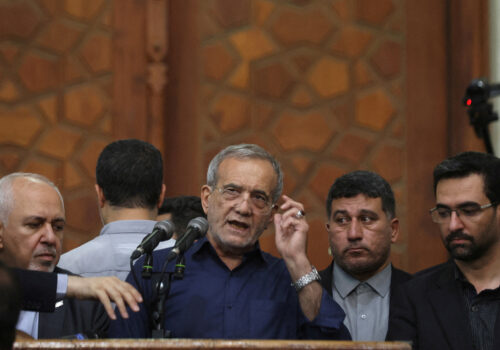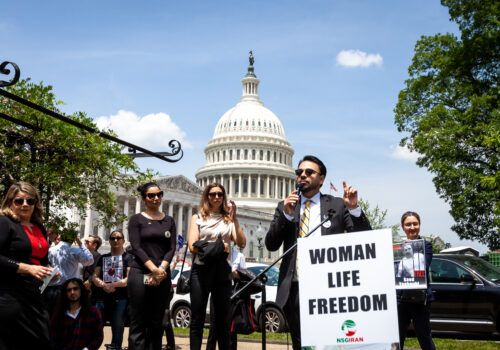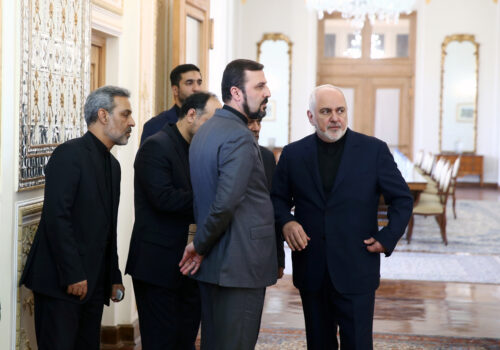Reformists on the ropes: How they are battling their own irrelevance and conservative dominance in Iran
On August 21, after days of deliberation, Iran’s parliament approved President Masoud Pezeshkian’s “national accord” cabinet. Notably, the conservative-dominated parliament did not reject any of Pezeshkian’s proposed nineteen ministers, a decision that defied expectations—making it the first cabinet to pass with flying colors since 2001.
While touted by some as an attempt at an all-inclusive government, the cross-factional composition of Pezeshkian’s cabinet has reduced the presence of reformist elements within his cabinet with Supreme Leader Ayatollah Ali Khamenei’s blessing, which Pezeshkian noted during the parliamentary voting process. (Khamenei later described his role as “consultation,” denying a direct role in the formation of Pezeshkian’s cabinet.)
Pezeshkian’s approach to his cabinet should not be surprising, as he made it clear during his campaign that he did not identify strictly with either camp, instead highlighting his unwavering loyalty to Khamenei. The decision not to include more reformists has potentially significant implications for their future role in Iranian politics. Reformists will likely struggle in the shifting political landscape, particularly against challenges from a conservative-dominated system, widespread disillusionment, and an overall failure to mobilize new social bases.
Around one-quarter of the ministers, including those holding key portfolios—intelligence, justice, and interior—hailed from the various segments of the principalist faction, including its more hardline elements, while the rest were affiliated with the various stripes of the broad reformist camp that includes left and center-left groups. The diminished reformist presence within Pezeshkian’s cabinet is particularly striking given that the reformist political machinery was the backbone of Pezeshkian’s electoral campaign; without its support, his presidential victory would have been impossible.
SIGN UP FOR THIS WEEK IN THE MIDEAST NEWSLETTER
These developments have led to a lukewarm reception for Pezeshkian’s government among some in pro-reform circles. Reformist figures such as Rahmatollah Beygdeli and Jalil Rahimi Jahan Abadi criticized the strong presence in the cabinet of rival principalists who lost the elections. Reformists were also unhappy with Pezeshkian’s exclusion of figures from religious and ethnic communities, women, and youth from the cabinet, an issue that the president sought to address by appointing a Sunni Kurd as vice president for rural and deprived areas and two women, one as a minister and the other as government spokesperson. Similarly, while expressing dismay at the composition of Pezeshkian’s cabinet, Esmail Gerami-Moghadam, the spokesperson of the Reformist National Trust Party, said the party would continue to support the new president and grant him a chance to bridge deep partisan divisions. Some reports have also suggested that former reformist President Mohammad Khatami has called for supporting Pezeshkian’s cabinet despite its makeup.
However, domestic discontent has also shaped the reformist trajectory in recent years. Since the eruption of several waves of nationwide protests since December 2017–January 2018, reformists have seen their social base erode, leading to humiliating defeats in the 2020 and 2024 parliamentary elections and the 2021 presidential election. While the unelected Guardian Council’s mass disqualification of reformist figures has played a role in their shrinking popularity, there has been a growing belief among large numbers of Iranians that reformists are fundamentally part of the regime. This was best represented in popular slogans such as “reformist, hardliner, the game is over” chanted during past years’ anti-regime protests. Nearly three decades after the reformists’ first victory under Khatami in 1997, many now view reforming the Islamic Republic as a dead end.
Oppositional activity and the fraught quest for a new social base
Despite winning only 53 percent of the vote in an election boycotted by more than half of eligible voters, Pezeshkian’s victory—supported by the reformists and many Iranians who simply feared his hardliner rival Saeed Jalili’s rule—has important implications for the complicated role that reformists have historically played within the Iranian system. Traditionally, the reformists have occupied a gray area within the Islamic Republic whereby, despite having an important share of power through elected institutions of the Islamic Republic such as the government and parliament, they have also acted as the managed internal opposition against the powerful unelected pillars of the system and their ideological rigidity by voicing the aspirations of the urban middle class and women for social-political liberalization and economic improvement. However, since the December 2017–January 2018 protests and subsequent waves of dissent—culminating in the extensive 2022–2023 protests following Mahsa Jina Amini’s death—the center of gravity of oppositional activism has increasingly moved outside Iran, particularly to the West, where many Iranian opposition parties and activists are based. This trend began after the 2009 post-election protests known as the Green Movement and the gradual disillusionment of exiled former reformists with the possibility of change from within the regime.
For years, the political influence of reformists has waned to the point that their candidate in the 2021 presidential elections, Abdolnasser Hemmati, garnered only 8.4 percent of the vote. Despite their resurgence during the recent presidential elections, the dissatisfaction within reformist circles about their reduced role in Pezeshkian’s government might put reformists in an odd position. While they have one leg in government, some elements within the broader reformist camp might adopt an oppositional stance, particularly if they perceive Pezeshkian as failing to implement his calls for social, political, and economic reforms.
Tapping into ethnic support
In the face of overall dwindling support for reformists, Iran’s ethnically diverse periphery, which likely comprises nearly half of the population and harbors long-standing grievances over cultural and political rights and economic underdevelopment, could be a crucial new base for reformists. Pezeshkian sought to capitalize on his ethnic background, particularly by mobilizing his fellow ethnic Turks—a crucial move for his victory. Pezeshkian’s personal appeals and connections to Turkish voters aside, the question of ethnicity remains politically sensitive within the Iranian system as the state has historically adopted a securitized approach toward ethnic communities and their demands, particularly among non-Shia ethnic groups, for more political representation and greater shares of power at regional and national levels. Despite electoral rhetoric, reformists have yet to articulate a serious platform to address these grievances. Pezeshkian has faced criticism from Sunni Kurdish and Baluchi political factions for this significant marginalization, and many see his appointment of Abdolkarim Hosseinzadeh, a Sunni, as vice president of rural and disadvantaged areas as a meaningless and token move. (Sunnis comprise between 10–25 percent of the Iranian population.)
Given the constrained environment within the Islamic Republic and the dominance of conservative elements, combined with reformists’ reluctance or inability to mobilize new social bases—such as a new generation of youth and ethnic groups—reformists’ influence appears to be in decline. The renewed opportunity given to Pezeshkian by sections of the Iranian electorate—after a series of poor electoral performances by reformists in recent years—has raised expectations for his performance. However, the considerable presence of non-reformist figures in his cabinet, coupled with Khamenei’s strong influence over its composition and recent police crackdowns on fundamental social liberty issues such as the hijab and worker strikes, do not bode well for Pezeshkian or his reformist allies.
The monumental challenges facing the Pezeshkian administration, and the considerable skepticism regarding his chances of success, are due, in part, to his unwavering loyalty to Khamenei. Deep antagonism of the clerical establishment and its deteriorating governance make the regime unstable and susceptible to more social turbulence. However, while the Women, Life, Freedom uprising led to the unprecedented rejuvenation of external opposition groups, the disbanding of a critical opposition coalition known as the Georgetown Eight highlighted the internal weaknesses of these groups and their inability to coalesce around a joint objective or capitalize on future opportunities such as another uprising. In light of these dynamics, the future of Iran’s political landscape remains unclear, with the reformists’ limited role and the opposition’s fragmentation posing significant obstacles to meaningful change.
Mohammed A. Salih is a senior fellow with the Foreign Policy Research Institute in Pennsylvania. Follow him on X: @MohammedASalih.
Further reading
Thu, Jul 18, 2024
Pezeshkian’s election could become a burden for Israel
IranSource By Raz Zimmt
President-elect Masoud Pezeshkian’s views on Israel mirror the current consensus among Iranian decision-makers.
Tue, Sep 10, 2024
Iranian-Americans have discovered their voice. Their activism will only grow stronger.
IranSource By Siamak Aram
It is rooted in Iranians’ deep desire for sweeping political and societal transformation, specifically removing the Islamic Republic.
Wed, Mar 27, 2024
Ex-minister Zarif confirms Iran’s reform movement is dead
IranSource By Shay Khatiri
The audio leak confirms that there was, in fact, a sincere reform movement in the 1990s, and now that movement is dead.
Image: Iran’s new President, Masoud Pezeshkian (4th R), is speaking with lawmakers in the Iranian Parliament in Tehran, Iran, on August 17, 2024. Iranian lawmakers are examining the qualifications of the ministers proposed by new Iranian President, Masoud Pezeshkian, in the public hall of the parliament. (Photo by Morteza Nikoubazl/NurPhoto)



